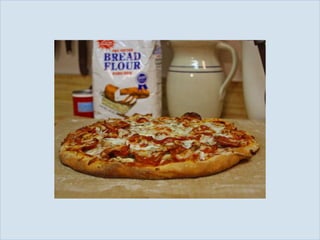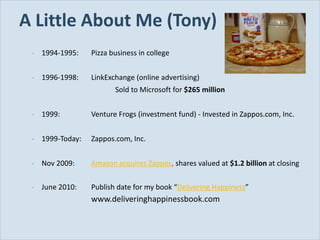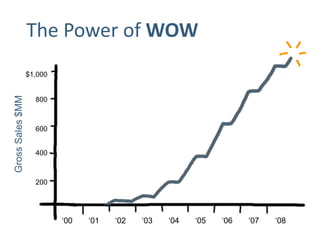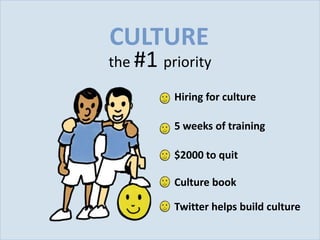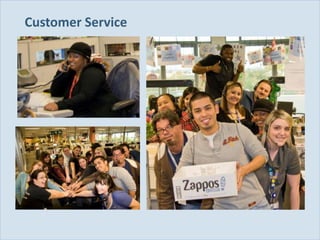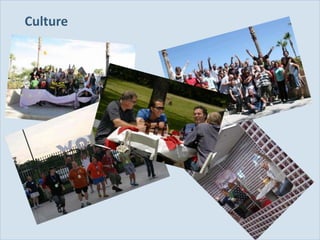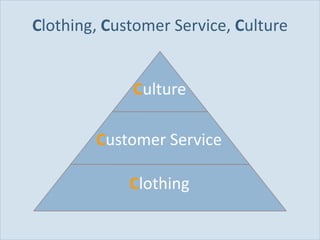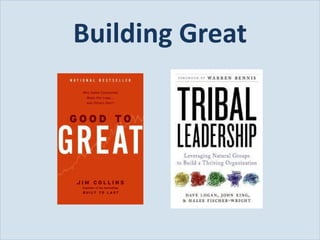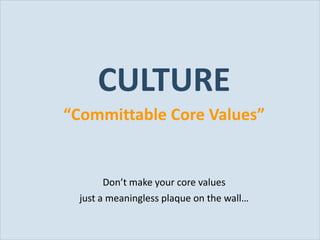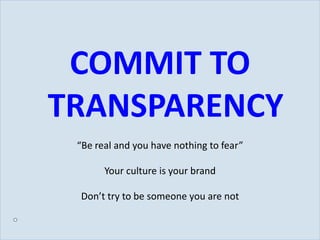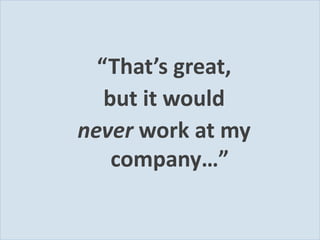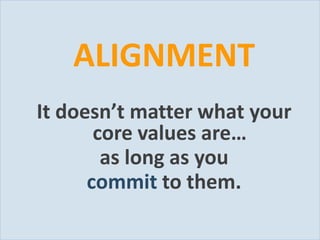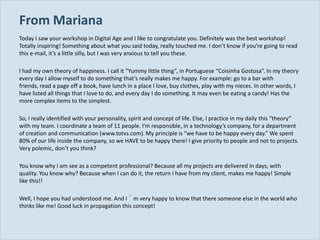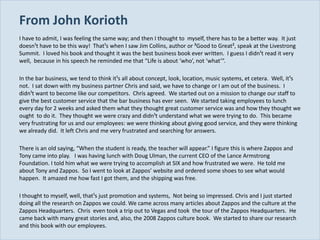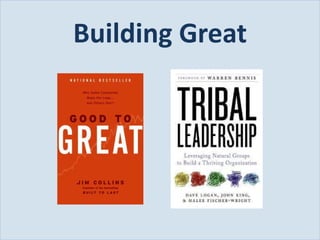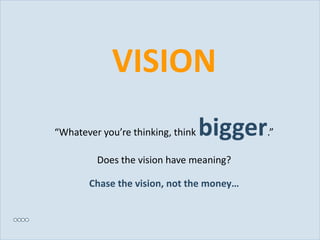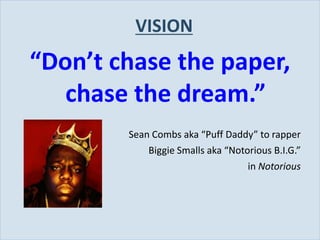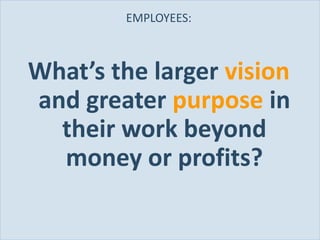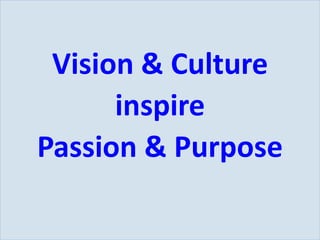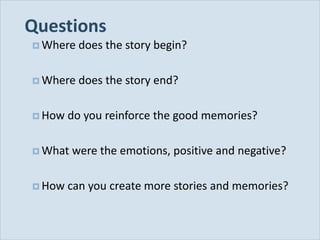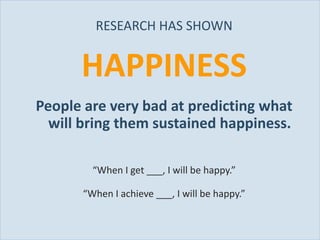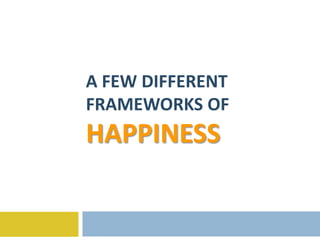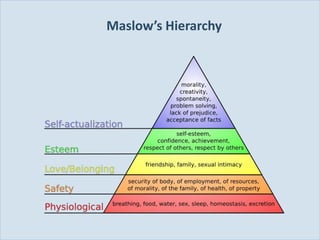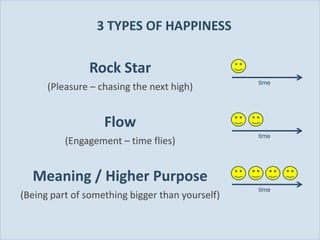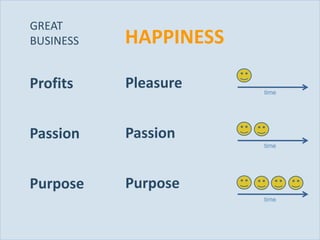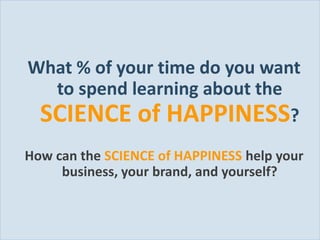Tony Hsieh - Delivering Happiness
- 1. DELIVERING HAPPINESS A PATH TO PROFITS, PASSION, AND PURPOSE Tony Hsieh Vator Splash May 13, 2010
- 2. Slide 2
- 3. A Little About Me (Tony) • 1994-1995: Pizza business in college • 1996-1998: LinkExchange (online advertising) Sold to Microsoft for $265 million • 1999: Venture Frogs (investment fund) - Invested in Zappos.com, Inc. • 1999-Today: Zappos.com, Inc. • Nov 2009: Amazon acquires Zappos, shares valued at $1.2 billion at closing • June 2010: Publish date for my book “Delivering Happiness” www.deliveringhappinessbook.com Slide 3
- 4. The Power of WOW $1,000 Gross Sales $MM 800 600 400 200 ‘00 ‘01 ‘02 ‘03 ‘04 ‘05 ‘06 ‘07 ‘08 Slide 4
- 5. Customer Experience What do customers expect? What do customers actually experience? What emotions do customers feel? What stories do they tell their friends? How can culture create more stories and memories? Slide 5
- 6. CULTURE the #1 priority Hiring for culture 5 weeks of training $2000 to quit Culture book Twitter helps build culture Slide 6
- 7. Clothing, Customer Service, Culture Culture Customer Service Clothing Slide 7
- 10. Culture Slide 10
- 11. Clothing, Customer Service, Culture Culture Customer Service Clothing Slide 11
- 12. Delivering Happiness (customers and employees) “People may not remember exactly what you did or what you said, but they will always remember how you made them feel.” Slide 12
- 14. CULTURE “Committable Core Values” Don’t make your core values just a meaningless plaque on the wall… Slide 14
- 15. Example: Core Values 1. Deliver WOW Through Service 2. Embrace and Drive Change 3. Create Fun and a Little Weirdness 4. Be Adventurous, Creative, and Open-Minded 5. Pursue Growth and Learning 6. Build Open and Honest Relationships With Communication 7. Build a Positive Team and Family Spirit 8. Do More with Less 9. Be Passionate and Determined 10. Be Humble Slide 15
- 16. COMMIT TO TRANSPARENCY “Be real and you have nothing to fear” Your culture is your brand Don’t try to be someone you are not Slide 16
- 17. “That’s great, but it would never work at my company…” Slide 17
- 18. ALIGNMENT It doesn’t matter what your core values are… as long as you commit to them. Slide 18
- 19. From Mariana Today I saw your workshop in Digital Age and I like to congratulate you. Definitely was the best workshop! Totally inspiring! Something about what you said today, really touched me. I don’t know if you’re going to read this e-mail, it’s a little silly, but I was very anxious to tell you these. I had my own theory of happiness. I call it “Yummy little thing”, in Portuguese “Coisinha Gostosa”. In my theory every day I allow myself to do something that’s really makes me happy. For example: go to a bar with friends, read a page off a book, have lunch in a place I love, buy clothes, play with my nieces. In other words, I have listed all things that I love to do, and every day I do something. It may even be eating a candy! Has the more complex items to the simplest. So, I really identified with your personality, spirit and concept of life. Else, I practice in my daily this “theory” with my team. I coordinate a team of 11 people. I’m responsible, in a technology’s company, for a department of creation and communication (www.totvs.com). My principle is “we have to be happy every day.” We spent 80% of our life inside the company, so we HAVE to be happy there! I give priority to people and not to projects. Very polemic, don’t you think? You know why I am see as a competent professional? Because all my projects are delivered in days, with quality. You know why? Because when I can do it, the return I have from my client, makes me happy! Simple like this!! Well, I hope you had understood me. And I´m very happy to know that there someone else in the world who thinks like me! Good luck in propagation this concept! Slide 19
- 20. From John Korioth My name is John Korioth. I also go by the nickname “College.” It’s a long story I can tell you later, but yes, I did finish college. When I did finish college in 1990, the economy was almost as bad as it is today, and it was tough to get a job. A friend of mine was opening a bar and asked if I wanted to bartend until something more substantial came long. Nineteen years later, and I am still in the business. There have been some ins and outs during those 19 years, but today I co-own a bar (SIX) in Austin, Texas. We have 14 investors, and it just so happens that one of the more famous investors is Tour de France Champion Lance Armstrong. I have known Lance for more than 15 years, and he is one of my best friends. When he was diagnosed with testicular cancer in 1996, I left the bar business to co-found the Lance Armstrong Foundation with Lance. After three years of being the executive director, I left and went back into the bar business. I still help out at the Foundation as much as I possibly can and as much as they will let me. It is something that will always be close to my heart. We opened “SIX” in 2005, and just like a lot of new bars, things seemed to be great at first. We were the new game in town, and things were rolling our way. The nice thing about the bar business is when you first open and you do it right, you can really cash-flow fast. Everyone loves you when you’re new. The deciding factor in the bar business is, how do they love you after two years. This is where a lot of bars fail and have to shut down and totally reinvent themselves. Or at least they think they do. We started to go through this same cycle until I ran into two of my competitors. They were absolutely miserable; both wanted to sell their bars or just shut them down. They hated everything about the business and, most of all, they disliked their employees. Slide 20 pretty sure their employees didn’t much like them. I am
- 21. From John Korioth I have to admit, I was feeling the same way; and then I thought to myself, there has to be a better way. It just doesn¹t have to be this way! That¹s when I saw Jim Collins, author or ³Good to Great², speak at the Livestrong Summit. I loved his book and thought it was the best business book ever written. I guess I didn¹t read it very well, because in his speech he reminded me that “Life is about ‘who’, not ‘what’”. In the bar business, we tend to think it¹s all about concept, look, location, music systems, et cetera. Well, it¹s not. I sat down with my business partner Chris and said, we have to change or I am out of the business. I didn¹t want to become like our competitors. Chris agreed. We started out on a mission to change our staff to give the best customer service that the bar business has ever seen. We started taking employees to lunch every day for 2 weeks and asked them what they thought great customer service was and how they thought we ought to do it. They thought we were crazy and didn¹t understand what we were trying to do. This became very frustrating for us and our employees: we were thinking about giving good service, and they were thinking we already did. It left Chris and me very frustrated and searching for answers. There is an old saying, “When the student is ready, the teacher will appear.” I figure this is where Zappos and Tony came into play. I was having lunch with Doug Ulman, the current CEO of the Lance Armstrong Foundation. I told him what we were trying to accomplish at SIX and how frustrated we were. He told me about Tony and Zappos. So I went to look at Zappos’ website and ordered some shoes to see what would happen. It amazed me how fast I got them, and the shipping was free. I thought to myself, well, that¹s just promotion and systems, Not being so impressed. Chris and I just started doing all the research on Zappos we could. We came across many articles about Zappos and the culture at the Zappos Headquarters. Chris even took a trip out to Vegas and took the tour of the Zappos Headquarters. He came back with many great stories and, also, the 2008 Zappos culture book. We started to share our research and this book with our employees. Slide 21
- 22. From John Korioth We really knew that Zappos and Tony were starting to have an effect on our business when we saw him speak at the South by Southwest Music Festival, a big music and interactive festival that has been going on in Austin for over 25 years. You might be thinking that we went down to an auditorium and watched with a couple of thousand other people - well, we didn¹t. I didn¹t even know he was going to be speaking. It was one of our cocktail waitresses (Julie) who understood very well what we were trying to accomplish, and she found it online and shared it with the rest of the staff. When she did that, we knew we had changed the culture of SIX. Of all the bars that Chris, myself and many other of our employees had worked at, we had never seen or heard of the staff sharing this type of information with one another. When I watched Tony speak, the one thing he spoke of that really stuck out to us was that he didn’t want to be the same run-of-the-mill internet company. He wanted to be part of something different and better. Even though they were selling shoes like a bunch of other companies, they wanted something better, something more rewarding, a company that was going to set them apart from the rest and make himself and the rest of the employees happy to come to work. This was preaching to the choir, but how? During Tony’s speech something he said something that we never really thought about and it was that you may think that Zappos priority was “customer service”. Tony explained that the number one priority at Zappos was really “company culture”. If you get the culture right the rest of the stuff will just happen naturally. Over the course of the next six months, which was eight months after our initial thought to change, we learned what Zappos had figured out: It’s about the culture of your business that derives everything good and bad. You want to have great customer service? You better have a great culture. You want employee retention? You better have a great culture. Slide 22
- 23. From John Korioth How did we do this? We started to pay more attention to our employees and what they were telling us, We got them more involved in the process of decisions. We started to give them better customer service. For example: At the end of every night a simple manager log is created and emailed to all the managers and owners. It has the sales numbers and general thoughts of how the night went. It also has maintenance items that the employees may have noticed or just thoughts on how they think the night could have gone better. If they list a maintenance item we do everything we possibly can do to have that item fixed by the time they walk in the next day for work. We also call, email or text them and tell them we fixed the problem or that we are working on it. This tells them that we listen to them and we take it seriously. If it is an idea that they might have to improve the customer experience or work environment, Chris or myself will follow up with them in person to discuss it. Another example is most employees in the service industry hate employee meetings. They are usually on their day off and are full of information they already know. We took a hard look at how to make these more enjoyable, interactive and more rewarding. We now usually take them to dinner instead of hosting the meeting at our location. This puts them in a different mindset of something new and interesting. We may also require them to be prepared to tell a story of some good or bad customer service experience they encountered at another business. This usually results in some good laughs and some good moments of perspective of how they should treat our customers. I use to spend 20 minutes preparing for these meetings now I take 4 hours, it makes all the difference in the world. Slide 23
- 24. From John Korioth What does this do for us? Everything! Employee retention is way better than any other place I have ever worked or owned. All of our cocktail waitresses are part time due to the nature of our business. Most of them have other part time jobs or are in school. Just the other day I was talking to one of them (Kathleen) and she told me that she had 7 other jobs in the past year and she quit all of them because the work environment was so bad and nothing compared to SIX. The last meeting employee meeting we had one of our oldest employees (Rod) stood up out of the blue and said he had worked at 10 other bars and restaurants and they never discussed the things we do and it has totally changed the way he looks at coming to work. When a customer walks into a our place and sees the same people working it makes them feel at home. It may sound cheesy from the TV show Cheers but “you want to go to a place where everyone knows your name”. We are going into our 5th year of business, and we have matched the previous year¹s sales each year. You might be thinking that we should have experienced growth. This economy, and other circumstances, have hit other bars and restaurants in our area very hard. Some good establishments are down 30 - 40%. Every bar is probably down except us. We tend to think we are up 30% even though we just matched last year¹s sales. We know one reason for that is our culture and Zappos. The most rewarding thing to us is, when we are walking around in Austin and we see some of our friends, the first thing they say to us is that they were in SIX and our employees were just so nice. They ask me how I get them to act like that when other bars are not that way. I just smile and say, “Zappos, Baby.” I don’t tell them the whole story; I let them try and figure it out for themselves like we did. As I said earlier, “when the student is ready, the teacher will appear.” Thanks, Tony! Slide 24
- 26. VISION “Whatever you’re thinking, think bigger .” Does the vision have meaning? Chase the vision, not the money… Slide 26
- 27. VISION “Don’t chase the paper, chase the dream.” Sean Combs aka “Puff Daddy” to rapper Biggie Smalls aka “Notorious B.I.G.” in Notorious Slide 27
- 28. ENTREPRENEURS: “What would you be passionate about doing for 10 years even if you never made a dime?” Slide 28
- 29. EMPLOYEES: What’s the larger vision and greater purpose in their work beyond money or profits? Slide 29
- 30. VISION MOTIVATION vs. INSPIRATION Slide 30
- 31. Vision & Culture inspire Passion & Purpose Slide 31
- 32. Example of evolving vision and brand 1999 Selection 2003 Customer Service 2005 Culture and core values as our platform 2007 Personal Emotional Connection 2009 Delivering Happiness Slide 32
- 33. Slide 33
- 34. Questions Where does the story begin? Where does the story end? How do you reinforce the good memories? What were the emotions, positive and negative? How can you create more stories and memories? Slide 34
- 35. What’s your business? You’re not in the _______ business. Cirque du Soleil is not in the circus business. You’re in the experience and emotions business. You’re in the stories and memories business. Think bigger. Slide 35
- 36. TAKE A STEP BACK… WHAT IS YOUR GOAL IN LIFE?
- 37. WHAT IS YOUR GOAL IN LIFE? Grow Get a Great Boyfriend / Company Be Healthy Job Girlfriend why? why? why? why? Retire Early Find Soul Make Money Run Faster Mate why? why? why? why? Spend Time Run A w/ Family Buy A Home Get Married Marathon why? why? why? why? HAPPINESS Slide 37
- 38. RESEARCH HAS SHOWN HAPPINESS People are very bad at predicting what will bring them sustained happiness. “When I get ___, I will be happy.” “When I achieve ___, I will be happy.” Slide 38
- 39. HAPPINESS There is a SCIENCE behind many aspects of business including: conversion psychology of buying direct marketing customer acquisition metrics repeat customer behavior, etc. What if you spent just 10% of your time studying and learning the SCIENCE of HAPPINESS? How much HAPPIER could you be? Slide 39
- 40. WHAT IS YOUR GOAL IN LIFE? Grow Get a Great Boyfriend / Company Be Healthy Job Girlfriend why? why? why? why? Retire Early Find Soul Make Money Run Faster Mate why? why? why? why? Spend Time Run A w/ Family Buy A Home Get Married Marathon why? why? why? why? HAPPINESS Slide 40
- 41. A FEW DIFFERENT FRAMEWORKS OF HAPPINESS
- 42. A FEW DIFFERENT FRAMEWORKS ON HAPPINESS Perceived Control Perceived Progress Connectedness Vision / Meaning (Being part of something bigger than yourself) Slide 42
- 44. 3 TYPES OF HAPPINESS Rock Star time (Pleasure – chasing the next high) Flow time (Engagement – time flies) Meaning / Higher Purpose time (Being part of something bigger than yourself) Slide 44
- 45. RECOMMENDED BOOKS PEAK Chip Conley TRIBAL LEADERSHIP Dave Logan, John King & Halee Fischer-Wright FOUR HOUR WORK WEEK Tim Ferriss HAPPINESS HYPOTHESIS Jonathan Haidt Slide 45
- 46. Contact info and tours! Email tony@deliveringhappinessbook.com for: This presentation Free culture book (need physical mailing address) Go to http://tours.zappos.com for: Tour of Zappos offices when you’re next in Las Vegas (takes about an hour) Slide 46
- 47. GREAT BUSINESS Profits Passion Purpose Slide 47
- 48. GREAT BUSINESS HAPPINESS Profits Pleasure time Passion Passion time Purpose Purpose time Slide 48
- 49. What % of your time do you want to spend learning about the SCIENCE of HAPPINESS? How can the SCIENCE of HAPPINESS help your business, your brand, and yourself? Slide 49
- 50. If the research shows that vision / meaning / higher purpose leads to HAPPINESS… What is your company’s higher purpose? What is your higher purpose? Slide 50
- 52. My new book is titled “Delivering Happiness” To be published June 7, 2010 www.deliveringhappinessbook.com Slide 52
Editor's Notes
- Not sure how to handle
- Ok to relinquish rights with exception of smiley faces
- Ok to relinquish copyright
- Ok to relinquish copyright

